The Identification and Light Sensitivity of Japanese Woodblock Print ...
The Identification and Light Sensitivity of Japanese Woodblock Print ...
The Identification and Light Sensitivity of Japanese Woodblock Print ...
You also want an ePaper? Increase the reach of your titles
YUMPU automatically turns print PDFs into web optimized ePapers that Google loves.
Connors, Page 4 <strong>of</strong> 9<br />
<strong>of</strong> indigo <strong>and</strong> safflower red. <strong>The</strong> composition <strong>of</strong> the remaining purple passages could not<br />
be determined from their reflectance spectra. In the mixtures <strong>of</strong> safflower red <strong>and</strong><br />
dayflower blue, the more fugitive colorant seems to be safflower red. This is consistent<br />
with the observed greater light sensitivity <strong>of</strong> safflower red compared to dayflower blue<br />
measured in the passages <strong>of</strong> unmixed color. Figure 7 shows a difference spectrum<br />
describing the spectral changes produced during the fading <strong>of</strong> the purple area on Actor as<br />
Kintoki Hanhyôe by Kunisada, in the collection at the Carnegie Museum <strong>of</strong> Art. <strong>The</strong><br />
greatest increase in reflectance occurred around 540 nm, the absorbance peak for<br />
safflower red, indicating that the light exposure caused predominantly the destruction <strong>of</strong><br />
the safflower red in the purple mixture.<br />
<strong>The</strong> two purple areas showing the remarkably fast fading were also mixtures <strong>of</strong><br />
safflower red <strong>and</strong> dayflower blue on two prints from an untitled set <strong>of</strong> Eight Views <strong>of</strong> Edo<br />
by Hidemaro, in the collection at the Carnegie Museum <strong>of</strong> Art. Like the typical<br />
safflower–dayflower purple mixtures described in figure 7, these also faded mainly by<br />
loss <strong>of</strong> the safflower red from the mixture. On these two prints, however, the safflower<br />
red faded more rapidly from the purple mixture than was observed in the fading tests <strong>of</strong><br />
the unmixed safflower red areas on these prints. <strong>The</strong> reason for this finding is not known,<br />
but it suggests that a different safflower red could have been used for the purple mixture<br />
than was used for the applications <strong>of</strong> unmixed colorant in the red passages. It should also<br />
be noted that there were only a few eighteenth-century prints in this study that included<br />
well preserved purple areas. Early methods <strong>of</strong> preparing safflower red or <strong>of</strong> printing<br />
purple may have resulted in these unusually light sensitive mixtures.<br />
Green colorants<br />
Various green passages were studied, ranging in hue from yellow-green to bluegreen.<br />
Figure 8 shows the fading results from all eighty-two green areas tested. <strong>The</strong> range<br />
<strong>of</strong> fading behavior is wider than that seen for either red or blue colorants, with ∆E values<br />
between 0.1 <strong>and</strong> 4.4 after five minutes <strong>of</strong> exposure. <strong>The</strong> majority <strong>of</strong> green areas showed<br />
fading rates near Blue Wool #3, but some areas faded at rates near Blue Wool #2,<br />
indicating their greater light-sensitivity. <strong>The</strong> color change that occurred during the fading<br />
<strong>of</strong> most <strong>of</strong> these green passages was a loss <strong>of</strong> yellow. Figure 9 shows the difference<br />
spectrum after the fading <strong>of</strong> a green area on Actor as Oguri Hangan by Kunisada, in the<br />
Collection at the Carnegie Museum <strong>of</strong> Art. <strong>The</strong> greatest change was produced between<br />
400–500 nm, indicating fading <strong>of</strong> a yellow component in a mixture. While dayflower<br />
blue <strong>and</strong> indigo also showed a reflectance increase between 400–500 nm during the<br />
fading tests, the increase experienced by a mixture <strong>of</strong> yellow with either <strong>of</strong> these blue<br />
colorants was greater than that experienced by the blue colorant alone.<br />
Green passages were typically created using yellow-blue colorant mixtures, by<br />
overprinting yellow <strong>and</strong> blue colorants, or by using the green mineral pigment malachite<br />
(Keyes 1988; Feller, Curran, <strong>and</strong> Bailie 1984). Half <strong>of</strong> the green areas studied showed<br />
reflectance spectra indicating the presence <strong>of</strong> indigo, while only one print contained<br />
green passages created from a mixture <strong>of</strong> dayflower blue <strong>and</strong> a yellow colorant. <strong>The</strong><br />
composition <strong>of</strong> the remaining green passages could not be identified because <strong>of</strong> the lack<br />
<strong>of</strong> distinctive features in their reflectance spectra.



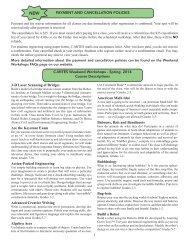

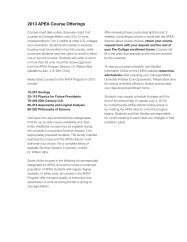

![Pittsburgh Neighborhoods [.pdf] - Carnegie Mellon University](https://img.yumpu.com/22011290/1/190x115/pittsburgh-neighborhoods-pdf-carnegie-mellon-university.jpg?quality=85)
![Curriculum Vitae [.pdf] - Carnegie Mellon University](https://img.yumpu.com/20737100/1/190x245/curriculum-vitae-pdf-carnegie-mellon-university.jpg?quality=85)
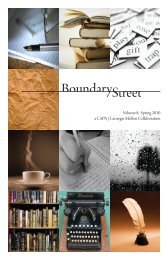
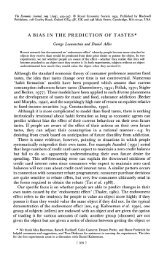
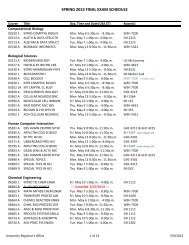
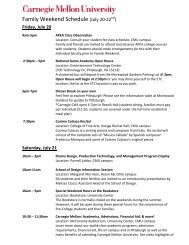
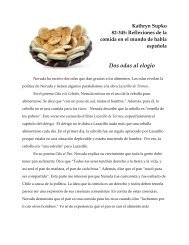


![May 2012 [.pdf] - Carnegie Mellon University](https://img.yumpu.com/12198417/1/190x253/may-2012-pdf-carnegie-mellon-university.jpg?quality=85)
